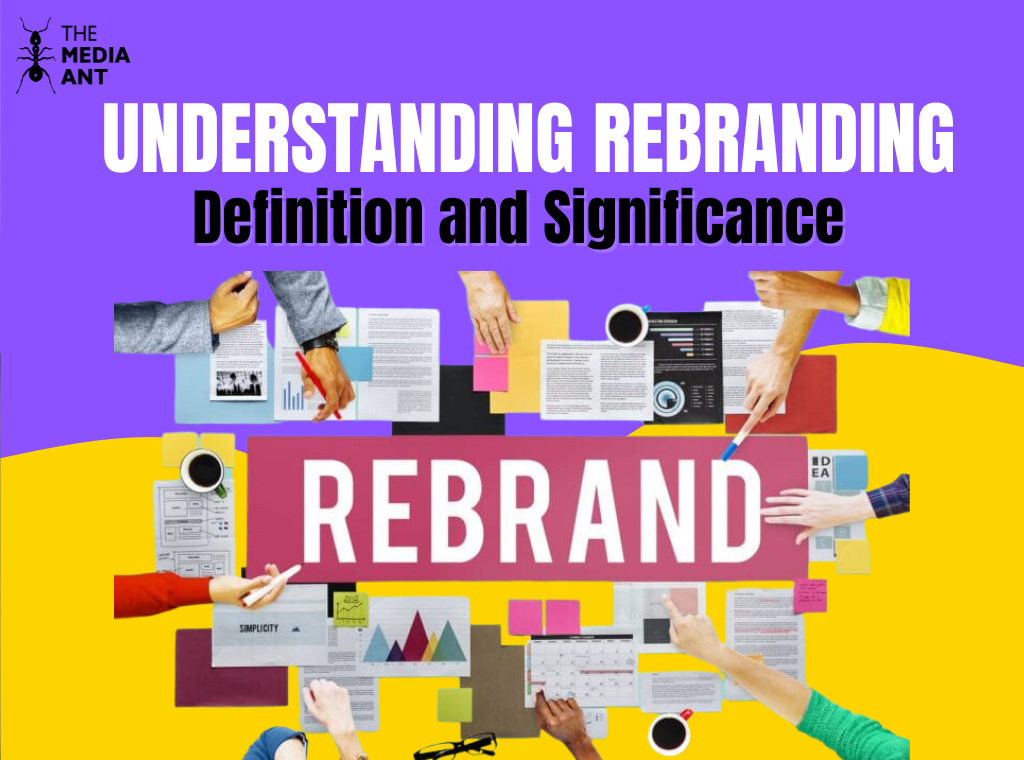Rebranding is a strategic process that involves making significant changes to a company’s brand identity, including its name, logo, visual elements, messaging, and positioning in the market. It’s a proactive step taken by businesses to reinvent themselves, stay relevant, and better connect with their target audience. In this comprehensive guide, we’ll explore the meaning and importance of rebranding, when a brand should consider rebranding, different types of rebranding, and effective rebranding strategies in 2024.
What is Rebranding?
Rebranding refers to the process of making substantial changes to a company’s brand identity to create a new image, perception, or positioning in the market. It goes beyond simply updating a logo or redesigning packaging; it involves redefining the brand’s essence, values, and identity to reflect its evolving goals, aspirations, and target audience. Rebranding can encompass various elements such as a new name, logo, visual identity, messaging, and even a shift in the company’s mission, vision, or values.
Importance of Rebranding
Rebranding is crucial for businesses for several reasons:
Staying Relevant:
In a dynamic and ever-changing market landscape, businesses need to adapt to evolving consumer preferences, trends, and competitive pressures. Rebranding allows companies to refresh their image, update their messaging, and stay relevant in the eyes of their target audience.
Differentiation:
Rebranding provides an opportunity for businesses to differentiate themselves from competitors and carve out a unique identity in the market. By redefining their brand positioning, values, and messaging, companies can stand out from the crowd and attract the attention of consumers.
Expanding Market Reach:
Rebranding can help businesses expand into new markets or target new demographics by adjusting their brand image and messaging to resonate with different audiences. By repositioning their brand and adapting to local preferences, businesses can unlock new growth opportunities and reach untapped markets.
Reputation Management:
In cases where a company has faced negative publicity, rebranding can help repair its reputation and regain consumer trust. By redefining its image and messaging, a company can distance itself from past controversies and present a fresh face to the public.
Strategic Growth:
Rebranding often accompanies significant milestones in a company’s growth journey, such as mergers, acquisitions, or expansion into new product categories or markets. By aligning its brand identity with its strategic objectives, a company can signal to stakeholders its commitment to growth and innovation.
When should a brand consider rebranding?
A brand should consider rebranding when:
- Its current brand image and messaging are outdated or no longer resonate with its target audience.
- It undergoes a significant change in its business model, product offerings, or target market.
- It experiences a decline in market share, sales, or customer loyalty.
- It merges with or acquires another company, requiring a consolidation of brand identities.
- It wants to differentiate itself from competitors and stand out in the market.
Types of rebranding
Rebranding can take various forms, including:
- Visual Rebranding: This involves updating the brand’s visual identity, including its logo, color palette, typography, and design elements.
- Strategic Rebranding: This focuses on redefining the brand’s positioning, messaging, values, and target audience to better align with its business objectives and market dynamics.
- Cultural Rebranding: This addresses issues related to diversity, inclusion, and social responsibility, reflecting the company’s commitment to positive societal change.
- Product Rebranding: This entails renaming, redesigning, or repositioning a specific product or product line within the brand portfolio.
Rebranding Strategies in 2024
In 2024, rebranding strategies are evolving to meet the changing needs and expectations of consumers. Here are some effective rebranding strategies:
1. Digital-first Approach:
In an increasingly digital world, brands are prioritizing their online presence and digital experiences. A digital-first approach involves optimizing the brand’s digital channels, such as website, social media, and mobile apps, to deliver seamless and engaging experiences to consumers.
2. Purpose-driven Rebranding:
Consumers today expect brands to have a clear sense of purpose and to contribute positively to society. Purpose-driven rebranding involves aligning the brand’s identity, values, and actions with a meaningful cause or mission that resonates with its target audience.
3. Sustainability Initiatives:
Environmental sustainability is becoming a key concern for consumers, and brands are responding by integrating sustainability into their brand identity and messaging. Rebranding efforts may include highlighting eco-friendly practices, using sustainable materials, and promoting initiatives that support environmental conservation.
4. Personalization and AI Integration:
Advancements in artificial intelligence (AI) are enabling brands to deliver personalized experiences to consumers at scale. Rebranding strategies may involve leveraging AI-powered tools and technologies to analyze consumer data, predict preferences, and tailor marketing messages to individual needs and preferences.
5. Omni-channel Integration:
Consumers expect a seamless experience across all touchpoints, whether online or offline. Omni-channel rebranding involves integrating the brand’s messaging, visuals, and experiences across multiple channels and platforms to create a cohesive and consistent brand presence.
6. Storytelling and Brand Narrative:
Storytelling remains a powerful tool for connecting with consumers on an emotional level. Rebranding strategies may focus on crafting compelling brand narratives that engage, inspire, and resonate with the target audience, building stronger connections and brand loyalty.
In conclusion, rebranding is a strategic process that involves making significant changes to a company’s brand identity to stay relevant, differentiate itself, and connect with consumers on a deeper level. By understanding the importance of rebranding, knowing when to consider it, and implementing effective rebranding strategies, businesses can create more impactful marketing campaigns that resonate with consumers, drive engagement, and ultimately achieve their marketing objectives in 2024 and beyond.
Examples of Successful Rebranding
Victoria’s Secret
Victoria’s Secret has recently undergone a rebranding process that sets it apart from previous efforts. While the visual identity remains unchanged, the company made a significant announcement in August 2021. They have transitioned from featuring famous supermodel angels to the VS Collective, a group of ten women representing diverse skin colors, ages, and body shapes.
This new approach by Victoria’s Secret aims to convey a message of diversity and inclusivity, particularly targeting the new generation. The brand hopes that this fresh image will facilitate the development of new associate programs, innovative product collections, compelling content, and demonstrate support for causes that are important to women worldwide. Martha Pease, the company’s CMO, emphasized the creation of a platform that fosters stronger connections with women of all backgrounds.
Victoria’s Secret intends to distance itself from its previous image, which was often criticized as sexist and exclusively catering to a younger audience. However, it is important to acknowledge that this new image has faced opposition, with some perceiving it as utilitarian and uninteresting. What are your thoughts on this matter?
Facebook/Meta

In October 2021, Mark Zuckerberg’s company made a significant announcement regarding its rebranding. The company, which encompasses Facebook, WhatsApp, Messenger, Instagram, and various other products, is now known as Meta. The transformation of Facebook’s brand is evident in the animation below, as it has undergone substantial changes. These changes include a new name, logo, and typeface. Additionally, Meta has introduced a new website for its parent brand, Meta.com.
According to the company, this rebranding aims to better reflect its expanding reach beyond social media and encompass its involvement in other areas, such as the metaverse, augmented reality (AR), and virtual reality (VR). By adopting the name Meta, Zuckerberg’s company intends to explore different business sectors and transition from traditional 2D screens to immersive experiences.
Indeed, this rebranding is a result of the company’s evolving vision, necessitating an update to its brand identity to align with its new direction.
FAQs on Rebranding
What is the main purpose of rebranding?
The main purpose of rebranding is to revitalize a company’s brand identity to better reflect its values, goals, and target audience. Rebranding can help businesses stay relevant in a changing market landscape, differentiate themselves from competitors, and connect with consumers on a deeper level. It may also be undertaken to address negative perceptions, reposition the brand in the market, or signal a strategic shift in the company’s direction.
How long does the rebranding process typically take?
The duration of the rebranding process can vary depending on the scope and complexity of the project. It may take anywhere from a few months to over a year to complete a rebranding initiative. Factors that can influence the timeline include the extent of changes to the brand identity, the involvement of stakeholders, the need for market research and consumer feedback, and the coordination of various teams and agencies involved in the process.
What are some common challenges associated with rebranding?
Some common challenges associated with rebranding include:
1. Resistance from internal stakeholders, such as employees or executives, who may be attached to the existing brand identity.
2. Maintaining consistency across all brand touchpoints and ensuring a smooth transition for customers.
3. Managing the costs and resources required for the rebranding process, including design, marketing, and implementation.
4. Avoiding negative backlash from consumers or the media, especially if the rebranding is perceived as too drastic or disconnected from the brand’s heritage.
5. Balancing the need for innovation and change with the desire to retain brand equity and familiarity.
How often should a company update or refresh its brand identity?
There is no one-size-fits-all answer to how often a company should update or refresh its brand identity, as it depends on various factors such as market trends, competitive landscape, and internal business objectives. Some companies may choose to refresh their brand identity every few years to stay current and maintain relevance, while others may go longer periods without significant changes. Ultimately, the decision to update or refresh a brand identity should be based on careful consideration of the brand’s positioning, consumer perceptions, and strategic goals.





